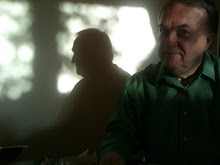Thrips are very small insects. Adult thrips are about 1mm in length. You have very likely experienced thrips if you rolled in grass, discove...
![[feature]](https://photos.smugmug.com/photos/i-j4CbmTV/0/ef5ea166/L/i-j4CbmTV-L.gif)
Thrips are very small insects. Adult thrips are about 1mm in length. You have very likely experienced thrips if you rolled in grass, discovered small bites on your arms or legs, and saw very small insects at the bite location. The bites are not dangerous, just annoying.
Many years ago I worked on thrips as a lab grunt at the United States Department of Agriculture lab at the University of California in Riverside (UCR). At the time there were four student workers, a single researcher and a technician named Jim. The main business of the USDA at UCR was the citrus industry and keeping it healthy. At the time, the lab was concerned with thrips as vectors of citrus diseases. I was tasked with finding a fluorescent dye that was "sticky" enough to stay on thrips and not hinder their movement, release the thrips, and then try to find the dyed thrips in the wild. It was like finding a needle in a haystack, but if I could find a thrip "x" distance away from the release point, then I could say it could travel that far. There were no directions as to the dye to use, so I used what I could find in the chemical cabinet.
First we had to raise the thrips. For some reason, though the city of Riverside was surrounded by citrus, we had to get lemons from the Limoneira Company in Ventura, 126 miles away. Jim and I would leave Riverside early in the morning in a university pickup truck to fill the bed with the lemons. It was a great opportunity to learn about Jim. He was a former marine, a veteran of the Pacific in World War II who had witnessed the attack on Pearl Harbor from his barracks. A day on the road with Jim was plenty of opportunity to hear his stories. At my young age, he had a lot more stories than me. He was not an expert on thrips, but he knew his citrus. He was also an expert on government work: do the task, don't ask questions. We picked the fruit, and took the more leisurely route down the Pacific Coast Highway with lunch on a pier in Malibu.
The next day we took the lemons to an old Sunkist fruit packing warehouse near downtown Riverside. I had passed this building hundreds of times and always assumed it was empty, but apparently the university had use of it, as Jim had the keys to the plant. Soon with the flick of some large switches, we had the place humming. We dumped the lemons on the conveyer belts. The fruit was washed, waxed, and dropped into boxes. We stored the lemons in an underground vault back at the lab. The fruit was used to propagate and then collect the thrips, a task done by smaller, steadier hands than mine.
Next, I dyed the propagated thrips. I had two locations where I released the thrips. One was a grove along the historic Victoria Avenue in Riverside, and the other was run by the Church of Latter Day Saints. At each drop location, I set up sticky yellow cardboard traps, each at a measured distance from the released thrips.
A week later I would collect the traps and examine them for dyed thrips. I would find plenty of thrips, but not dyed. Did they lose their dye, or simply not find the trap? "Rinse and repeat" with a new dye the next week. Another trip with Jim, more releases and more traps. This went on for several weeks until finally... I got a call to work in another lab!
Recently I observed thrips on the Lazy Susans at the TownHouse Garden.
Since the thrips are so small, I setup a usb microscrope on the MacBook Air and used the PhotoBooth app to capture video of the them at work.
As in "Horton Hears a Who", the video showed me an other-worldly scene. An alien landscape of Suessian trees and plants with giant creatures roaming the landscape. I added some eerie sound effects using the birds in the garden. The lighter colored creatures are the early in-stars (pre-adult form) of the thrips. The dark ones are the adults. Thrips undergo incomplete metamorphosis, that is the young look like smaller versions of the adults minus wings. The young and adults feed on the same food.
Now with the knowledge gained from the video that pollen sticks to the thrips, maybe I should have used a colorful plant spice like turmeric or one of the dyes from a Holi festival as my thrip dye. I'll write a note to the 23 year old me just in case I see a DeLorean with a flux capacitor.























COMMENTS